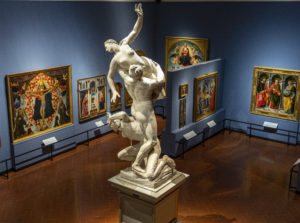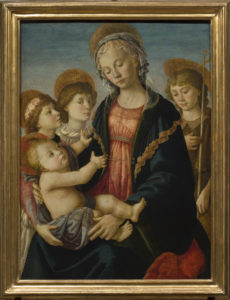The Accademia’s Renovated ‘Sala del Colosso’ Unveiled

The Accademia Gallery has presented the newest layout of the Sala del Colosso, the first room in the historic museum. This room was previously closed for renovation for months, and has finally reopened to the public on Tuesday, February 8.
Some of the changes include a vibrant hue of deep blue painted on the walls and improvements in lighting. Compared to the previous single bright light, the room is now overall darker with spotlights above each specific artwork. These additions have enhanced the effect of the already beautiful artwork featured in this room to be even more striking. To see a video, click here. As well as changes made to the original room, a separate, smaller room was created to specifically house paintings from the fifteenth century.
The Sala del Colosso is a room full of Florentine paintings from the medieval-renaissance period, with works by Neri di Bicci, Lorenzo di Credi, Paolo Uccello, Filippino Lippi and Botticelli, several of which have been restored. The original clay model of the famous Rapine of the Sabine Women by Giambologna (1574-80) is placed in the center of the room, while the finished marble statue is located in the Loggia dei Lanzi in Piazza Signoria.

This opening also marks the return of some paintings that were previously abroad and shown in other museums. Most notably, two paintings attributed to Botticelli that have been showcased at foreign museums are back. One, Madonna and Child with the Young Saint John and Two Angels is one of Botticelli’s earliest works. The picture conveys intimacy and maternal love. It was shown in an exhibition in the Tyrolean State Museum in Austria.
Below that painting, In Madonna of the Sea, the background is a view of the beach, giving the painting’s namesake. The Child is holding a pomegranate, which can be interpreted as symbolizing the passion and passing of Christ.
Also making its return is Botticelli’s Pala del Trebbio. This work was displayed at The Musée Jacquemart-André in Paris as a part of an exhibition dedicated to celebrating Botticelli’s accomplishments. This particular painting plays a distinct role in Florence’s history as the saints portrayed are linked to the Medici family, such as Saints Cosmas and Damian among others. It came from the Medici villa of Trebbio and was displayed on the altar of the chapel.
Museum-goers can still look forward to more additions to the Accademia. The arrival of the bronze bust of Michelangelo by Daniele da Volterra is scheduled for February 15, due to the museum’s international connections.
These updates have been part of a series of renovations that have taken place at the Accademia over the course of closures during the COVID-19 pandemic. Earlier processes of renewal that have been completed include the implementation of an air conditioning system as well as safety procedures for COVID-19.
Work, however, is still ongoing. Lorenzo Bartolini’s plaster casts of Neoclassical sculptures are no longer in the Sala del Colosso, but are still scattered in the room displaying Michelangelo’s renowned David sculpture until the grand reopening of the section housing those works. (marissa conter)
